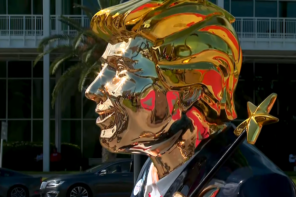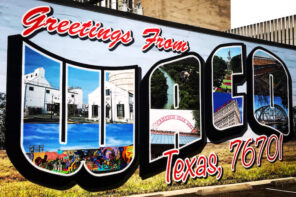Mark Driscoll used Pacific Northwest aesthetics to kindle an audience for Mars Hill Church’s conservative, neo-Reformed dogma. Now, Seattle’s creative community is tamping him down with wet newspaper.
Earlier this month, the city’s arts rag Seattle Weekly released a “Comic History of Northwest Cults,” counting the disgraced megachurch pastor as just the most recent in a long line of religious charlatans. Among SW’s wall of shame:
- Franz Edmund Creffield’s “Brides of Christ” involved mostly young women and ended in adultery, murder—and the founder’s claim to have caused the San Francisco earthquake of 1906.
- Judith Zebra Knight founded the Ramtha School of Enlightenment and made millions, claiming to channel an ancient deity she says conquered the lost city of Atlantis.
- Facing persecution on his Indian ashram for alleged prostitution, drug-smuggling and “free-love,” guru Baghwan Shree Rajneesh gathered thousands of followers to a headquarters in rural Oregon. Conflict with the natives yielded criminal charges against Rajneesh’s henchmen for wiretapping, arson, attempted murder and salmonella bioterrorism resulting in 751 cases of acute gastroenteritis.
- Paul Erdman went on an acid trip, changed his name to Love Jesus and founded a patriarchal commune in Seattle’s Queen Anne neighborhood, with him on top.
- Rejected as a preacher by other churches, Donald Barnett founded the Community Chapel and Bible Training Center, where worship included a “dancing revelation” and “healing touch.” Older men would kiss and fondle younger women and even children.
One man’s “cult” is another man’s treasure, but, offered the above examples, I’m not sure a 13,000-member megachurch belongs in the lineup. Driscoll was kicked out of the Acts 29 church-planting network he founded over his history of bullying and accusations of plagiarism and dishonest book promotion tactics.
If anything, Driscoll’s cult was one of celebrity, and his sins were PG-rated corruption compared to Seattle Weekly’s sexy list. Over at getreligion.org Julia Duin suggests you can’t expect much nuanced religion coverage from the alternative newsweekly, which barely covers the subject. Driscoll might have had a cult-leader personality, but, as Duin says, what he was preaching was “hardly esoteric.” Driscoll’s is a prominent “New Calvinist” Gospel, popularized by Reformed Baptists like John Piper, Southern Baptists like Al Mohler and Presbyterian Church in America preachers like Tim Keller.
Love him or hate him, but don’t confuse Driscoll with a religious innovator. That’s Driscoll’s wicked genius—to mask your great-grandfather’s us-and-them religion with an edgy façade. What made Driscoll stand out was his loud-mouth style, espousing traditional gender roles, for example, with the crassest of language. Like Lutheran pastor Nadia Bolz-Weber, Driscoll breaks prudish, churchy taboos and understands millennial culture. “Mars Hill members talk about sex, drink alcohol, get tattoos, and swear,” said Bitch magazine. “They listen to Fleet Foxes; they love Star Wars and graffiti art.” The Seattle Times said, “He drew pierced-and-tattooed congregants from Seattle to … Calvinist doctrine cloaked in indie-rock, big screens and a worn pair of Chuck Taylors.”
But none of this makes for the kind of epoch-shifting postmodern church that pop historians like Phyllis Tickle and Diana Butler Bass have described. In this “new kind” of Christianity, leaders like Bolz-Weber give their power away, while Driscoll clung fiercely to his fiefdom. Driscoll has sometimes been mislabeled as an “Emerging” or “Emergent” Christian. These labels are notoriously difficult to define, but exemplars like Solomon’s Porch in Minneapolis and Bolz-Weber’s House for All Sinners and Saints in Denver operate on communal meaning-making rather than top-down authority. In that limited sense, Mars Hill might have been more like a cult than an “emerging” church, but then, so did just about every religious community you’ve encountered—because after the Enlightenment, we’ve all been taught to ground our beliefs on something solid and indubitable, and religious teaching is no exception.
A slim-cut corduroy blazer or post-hardcore worship leader doesn’t make a truly new kind of church. Postmodern Christianity is nothing if not a tension of faith and doubt—a desolidification of authority—and no Seattle aesthetic can turn Mars-Hill-style rote memorization into Blue-Like-Jazz improvisation. One example: Many post-evangelicals flee to Emergent or mainline Protestant churches specifically in search of gender equality, while Driscoll has displayed infamous misogyny. Progressive Christians tend to ground their egalitarianism in the long trajectory of biblical narrative that seems to prophesy resurrection for all oppressed peoples. This move demands a creative attempt to see the big picture, whereas traditionalists like Driscoll find surety in those isolated proof texts that suggest a gender hierarchy. Former followers report feeling duped by the patriarchal theology hidden in Driscoll’s cool brand. One former Acts 29 member (who happens to play in my folk-rock band) called Driscoll’s legacy “fundamentalists in hipsters’ clothing.”
Driscoll gathered thousands of converts in a highly secular city using hip, millennial delivery, but now some of Seattle’s cultural gatekeepers have looked through the disguise and seen nothing but a cult leader. Putting Driscoll on the list of Seattle’s “Predators and Prophets” might be more inflammatory than informative, but it goes to show that mismatching medium and message is playing with fire.




